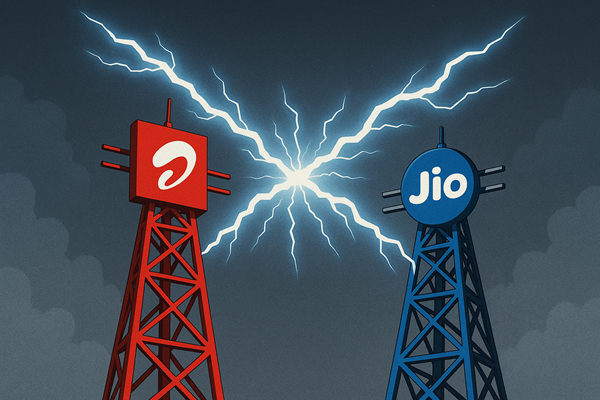.png)
India’s Growth Pops, But RBI Still Has Reasons To Cut Rates
A 7.4% GDP print in January–March 2025 flatters India’s outlook. With consumption weak and real rates high, RBI can still ease to lift growth.

By Yield Scribe
Yield Scribe is a bond trader with a macro lens and a habit of writing between trades. He follows cycles, rates, and the long arc of monetary intent.
June 1, 2025 at 5:59 AM IST
India’s economy grew far faster than expected in the fourth quarter of 2024–25, which shaved off some froth from the recent rally in bond prices as yields rose by 4-5 basis points following the release of the data on Friday.
But does this warrant a rethink of the macro theme that anticipates 50-75 basis points of monetary easing in 2025–26? Do the strong numbers for the January–March quarter suggest that India’s economy is in a Goldilocks environment of low inflation and high growth?
The answer is an emphatic no.
The reason: the growth spurt was less a signal of sustained momentum and more a result of backloaded public investment and a temporary tax boost from compressed subsidies. If anything, the Reserve Bank of India has more room now to cut interest rates without threatening macroeconomic stability.
GDP rose 7.4% year on year in the January–March 2025 quarter, the fastest pace in a year and well above Bloomberg’s consensus estimate of 6.8%.
On the face of it, this would suggest India is reaccelerating. But a closer look shows the headline number benefited from two transient forces, unusually strong government capital expenditure and a steep drop in subsidy disbursements.
Government capital expenditure surged 67% year on year in March alone, taking the full-year outlay to ₹10.52 trillion, well above the revised estimate of ₹10.18 trillion. This backloaded spending was a key driver of the 9.4% year-on-year rise in fixed investment, up from 5.2% in the October–December quarter.
In parallel, the collapse in imports contributed to a 3.7 percentage point boost from net exports, up from 2.8 percentage points the previous quarter. With imports contracting 12.7% and exports growing just 3.9%, the shift in trade volumes added significantly to real GDP.
The other driver of the GDP and GVA divergence was taxation. Net indirect taxes, which are calculated as indirect taxes minus subsidies, grew sharply because of a 44% drop in subsidy payments in the January–March quarter relative to a year ago. That alone accounted for a 60-basis-point wedge between GDP and gross value added, the widest gap since early 2024.
Growth Quality
Strip away these effects, and the economy looks far less exuberant. Annual GDP growth for 2024-25 came in at 6.5%, while gross value added rose 6.4%, both slower than the previous year’s readings of 9.2% and 8.6%, respectively. Even core GVA, which excludes agriculture and government services, rose only 6.7% in the January–March quarter, up from 6% the previous quarter.
More importantly, private consumption remained soft. Private consumption grew just 6% year on year, dragging its share of GDP to 53%, the lowest in over a year. Government consumption, meanwhile, contracted. Fiscal data showed current expenditure by both the central and state governments fell sequentially throughout the March quarter.
Yet the outlook may not be as gloomy as the consumption data suggests. Rural wages have picked up, the rabi harvest was strong, and tax cuts have bolstered urban demand. These tailwinds should lift household consumption. Government spending, too, has normalised post last year’s Lok Sabha elections.
Rate Room
That sets the stage for a supportive monetary policy stance. With one-year-ahead inflation projected at 4% and the one-year Treasury bill yield at 5.65%, the real interest rate stands at a relatively high 165 basis points. A system with 1-1.5% surplus liquidity could allow for a 50-basis-point reduction in the policy repo rate while keeping overnight rates aligned below it. A terminal operating rate of 5.35% to 5.40% is not only possible, but also necessary, if the RBI wants to align its policy with India’s growth potential.
And that potential remains a long-term challenge. As Dr Chakravarthy Rangarajan recently noted, India would need to grow at 7.41% annually until 2047 to achieve high-income status. Even 6.5% is not enough. Governor Sanjay Malhotra himself acknowledged in the April Monetary Policy Committee minutes that India aspires to more than being the fastest-growing large economy.
The message for the RBI is clear: the growth bump from the January–March quarter is welcome, but insufficient. Fiscal policy remains cautious. Private investment is yet to fire. Household consumption needs to be stimulated as domestic economy can only fire from this engine considering adverse global trade environment. To close the gap between current momentum and long-term ambition, interest rates need to do more of the work.
Bond yields may oscillate between 6.20% and 6.35% in the near term due to positioning, but the macro narrative still favours a drift lower toward 6%. The RBI must seize this moment to pivot. India needs more than one good quarter. It needs sustained acceleration, and that calls for lower rates.







